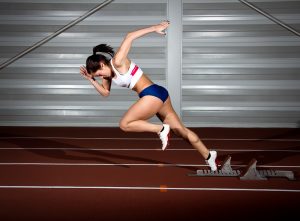One of my clients is now a British Champion at 100m (and high jump/long jump) after winning gold at the Transplant Games 2017 earlier this year in Glasgow. This blog is designed for personal trainers, fitness instructors and coaches to use with recreational, aspiring or professional sprinters out there.
Sprinting is made up of a few key sections:
- Start
- Acceleration
- Top Speed Running
- Maintenance
- Finish
Out of these the two that ‘us’ as coaches and athletes can improve on are Acceleration and Top Speed Running.
During Usain Bolts 100m world record in 2009 he ran the 100m in a time of 9.58! Bolts’ acceleration period only took 15m-20m by this time he was running at a velocity of 11m/s, from this point until 70m he reached his top speed 12.35m/s. If you remember correctly by this time he had already won the race, so for him the final 30m were a matter of formality and the only question left to answer – would he break his own world record he set in 2008 (9.69s) – of course he did!
During any period of the 100m or any sprint, there are 4 to 5 key areas that should be focused on and improved:
Acceleration
- Forward lean
- Ankle cross – the ankle should pass the stance leg low to the ground, wasting no energy and being as efficient as possible.
- Stance leg – the stance leg should be as rigid as possible, not collapsing.
- Knee drive – frontal running technique should be applied, not backwards running where the athletes kicks their bottom as running.
- Ground contact – quick contacts on the floor.
Top Speed Running
- More upright – still slight lean forward.
- Ankle cross – unlike during acceleration, the ankle should come high over the stance leg, in cycling motion.
- Stance leg – again, the stance leg should be rigid and should be right under their body giving them a solid base of support to push off from.
- Knee drive – frontal running technique should be applied, not backwards running where the athletes kicks their bottom as running.
- Ground contact – quick contacts on the floor, trying to minimise breaking forces.
To be able to sprint quickly there is one element that must be in place before all others, trunk stability. If the force that is being generated at the floor is dissipated at the trunk and is not realised to the full potential, it does not matter how good the running mechanics of the athletes are, they will never be able to sprint fast, so ensure you spend time improving your client’s or athlete’s trunk stability.


Leave a Reply